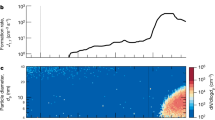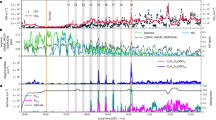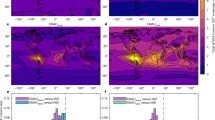Abstract
Large depletions in stratospheric ozone were first reported by Farman et al.1 at Halley Bay (76°S), and confirmed by satellite observations2. Chubachi3 gives a detailed account of ozone decreases and temperatures in the lower stratosphere during the spring of 1982 at 69°S. There is now evidence2 for annual declines in total ozone by ∼6 and 3% in regions of total ozone minima and maxima, respectively, from September to mid-October since the late 1970s. We propose here a chemical mechanism for the formation of the ozone hole. It involves removal of gaseous odd nitrogen by ion- and/or aerosol-catalysed conversion of N2O5 and ClONO2 to HNO3 vapour, followed by heteromolecular HNO3–H2O condensation, leading to HNO3–H2O aerosols. At an altitude of 17km, these processes start at temperatures below 205±5 K, well above the condensation temperature of pure water vapour. We propose that the absence of gaseous odd nitrogen and catalytic methane oxidation reactions driven by sunlight in early spring lead to large OH concentrations which rapidly convert HCl to ClOX. Catalytic reactions of ClOX and BrOX cause drastic ozone destructions and can account for the springtime ‘ozone hole’ first observed by Farman et al.1. By our model the depletion would be mainly due to emissions of industrial organic chlorine compounds. Arctic regions may also become affected. The depletion lasts while HNO3, but not HCl, is incorporated in the particles in the temperature range 205±5 K to 192 K.
This is a preview of subscription content, access via your institution
Access options
Subscribe to this journal
Receive 51 print issues and online access
$199.00 per year
only $3.90 per issue
Buy this article
- Purchase on SpringerLink
- Instant access to full article PDF
Prices may be subject to local taxes which are calculated during checkout
Similar content being viewed by others
References
Farman, J. C., Gardiner, B. G. & Shanklin, J. D. Nature 315, 207–210 (1985).
Stolarski, R. S. et al. Nature 322, 808–811.
Chubachi, S. in Handbook for MAP Vol 18 (ed. Kato, S.) 453–457 (SCOSTEP, Univ. Illinois, Urbana, 1985).
McElroy, M. B., Salawitch, R. J., Wofsy, S. C. & Logan, J. A. Nature 321, 759–762 (1986).
Solomon, S., Garcia, R. R., Rowland, F. S. & Wuebbles, D. J. Nature 321, 755–758 (1986).
McCormick, M. P., Steele, H. M., Hamill, P., Chu, W. P. & Swissler, T. J. J. atmos. Sci. 39, 1387–1397 (1982).
Steele, H. M., Hamill, P., McCormick, M. P. & Swissler, T. J. J. atmos. Sci. 40, 2055–2067 (1983).
Ferguson, E. E., Fehsenfeld, F. C. & Albritton, D. L. in Gas Phase Ion Chemistry Vol 1, 45–81 (Academic Press, 1979).
Böhringer, H., Fahey, D. W., Fehsenfeld, F. C. & Ferguson, E. E. Planet. Space Sci. 31, 185–191 (1983).
Arnold, F. & Crutzen, P. J. (in preparation).
Arnold, F. in Proc. DAHLEM Workshop on Atmospheric Chemistry (Ed. Goldberg, E. D.) 273 (1982).
Arnold, F. & Bührke, T. Nature 301, 293 (1983).
Ferguson, E. E. & Arnold, F. Acct. chem. Res. 14, 327 (1981).
Baldwin, A. C. & Golden, D. M. Science 206, 562–563 (1979).
Clavelin, J. L. & Mirabel, P. J. Chim. phys. 76, 533–537 (1979).
Forsythe, W. R. & Giauque, F. J. Am. chem. Soc. 64, 48–61 (1942).
Lau, Y. K., Ikuta, S. & Kebarle, P. J. Am. chem. Soc. 104, 1462–1469 (1982).
Austin, J. A., Garcia, R. R., Russell, J. M., Solomon, S. & Tuck, A. F. J. geophys. Res. 90, 5477–5485 (1986).
Evans, W. J. F., McElroy, C. T. & Galbally, J. E. Geophys. Res. Lett. 12, 825–828 (1985).
DeMore, W. B. et al. Chemical Kinetics and Photochemical Data for Use in Stratospheric Modeling, JPL Publication 85–37 (NASA Jet Propulsion Laboratory, California, 1985).
Crutzen, P. J. & Schmailzl, U. Planet. Space Sci. 31, 1009–1032 (1983).
Labitzke, K. J. geophys. Res. 86, 9665–9678 (1981).
Berg, W. W., Crutzen, P. J., Grahek, F. E., Gitlin, S. N. & Sedlacek, W. A. Geophys. Res. Lett. 7, 937–940 (1980).
Berg, W. W., Heidt, L. E., Pollock, W., Sperry, P. D. & Cicerone, R. J. Geophys. Res. Lett. 11, 429–432 (1984).
Molina, L. T. & Molina, M. J. phys. Chem. (submitted).
McCormick, M. P. & Trepte, C. R. J. geophys. Res. (submitted).
McKenzie, R. L. & Johnston, P. V. Geophys. Res. Lett. 11, 73–75 (1984).
Shibasaki, K. in Handbook for MAP Vol 18 (ed. Kato, S.) 506–509 (SCOSTER, Univ. Illinois, 1985).
World Meteorological Organization Atmospheric Ozone 1985, WMO Rep. no. 16 (WMO, Geneva, 1985).
Author information
Authors and Affiliations
Rights and permissions
About this article
Cite this article
Crutzen, P., Arnold, F. Nitric acid cloud formation in the cold Antarctic stratosphere: a major cause for the springtime ‘ozone hole’. Nature 324, 651–655 (1986). https://doi.org/10.1038/324651a0
Received:
Accepted:
Issue Date:
DOI: https://doi.org/10.1038/324651a0
This article is cited by
-
Dependence of column ozone on future ODSs and GHGs in the variability of 500-ensemble members
Scientific Reports (2023)
-
Calcium poisoning mechanism on the selective catalytic reduction of NOx by ammonia over the γ-Fe2O3 (001) surface
Environmental Science and Pollution Research (2022)
-
Effect of ultraviolet radiation (UVR) on the life stages of fish
Reviews in Fish Biology and Fisheries (2020)
-
Stratospheric ozone: down and up through the anthropocene
ChemTexts (2019)
-
The Effect of Super Volcanic Eruptions on Ozone Depletion in a Chemistry-Climate Model
Advances in Atmospheric Sciences (2019)



